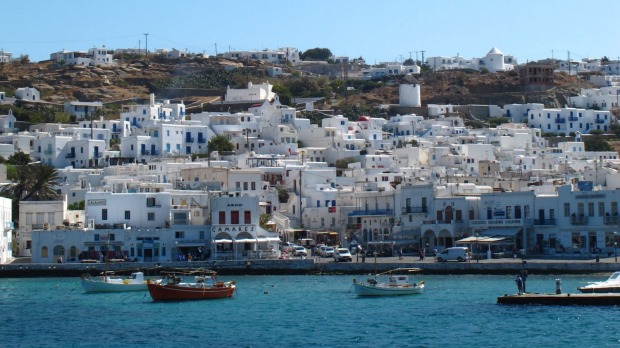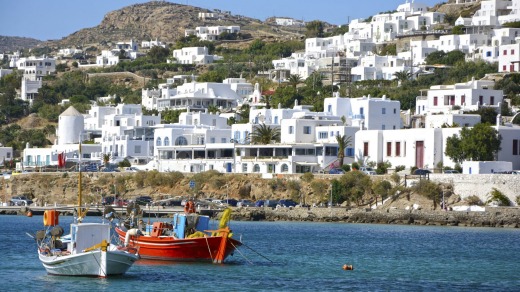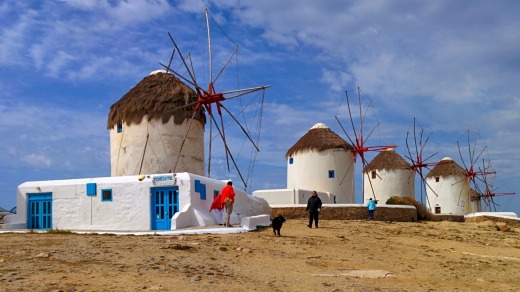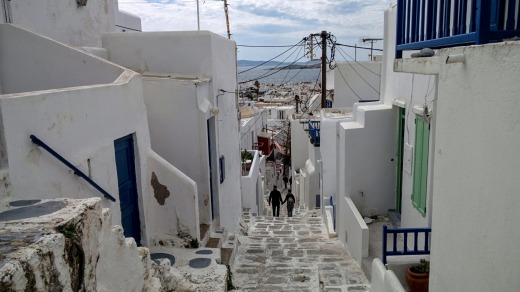

Tucked into one of Mykonos' labyrinthine, whitewashed passageways, built to confuse pirates and confound the island's prevailing winds, we're gorging on homemade chocolate millefeuille and Revani syrup cake with excellent cappuccino.
We're pretty certain that Popolo cafe in Drakopoulou Street, run by a friendly husband and wife team, is in the same spot we spent ravenous mornings sitting over our meagre breakfast of coffee and fried eggs for my partner, Rob, and a bowl of yoghurt and honey for me. It was all we could afford back in the spring of 1979.

Back then, we were trying to eke a living sending regular stories back to the Illawarra Mercury. Living cheaply on Mykonos for a while seemed like a good idea, but being young and silly, we managed to misjudge almost everything.
We ran out of drachmas, we seriously underestimated the climate – a northern hemisphere island spring is not the same as a Sydney spring – we took too few warm clothes and too little reading matter.
Old port Mykonos today, with its sugar-cube village and luminous light, looks much like 1970s Mykonos thanks to its protected Cycladic architecture, but it's worlds away. We've returned under far different circumstances, cradled in luxury aboard the cruise ship Le Soleal, which APT has chartered for its Ancient Mediterranean cruise.

We've been ferried ashore on Le Soleal's comfortable tender, closed to wind and waves.
On our first Mykonos foray, we had to clamber down a ladder into a rowing boat off the bucking Naias ferry from Piraeus, in weather so bad we couldn't see Mykonos for the waves. (According to a Greek shipping site, the Naias was "arrested for safety reasons" in 2000 and scrapped.)
Back then, we were blissfully unaware that our slow and grimy ferry was a ship to be avoided – her sister ship, the Express Samina, went down tragically off Paros in 2000, killing 82 people. Once ashore we were met by the original Mykonos mascot, Petros the Pink Pelican, who was then only a stripling of 30 – he was run over seven years later to extensive Mykonian mourning, and quickly replaced by other pelican mascots, but he was our first and daily greeter.
So was our host Mrs Griparis, the Mykonos version of The Widow, played by Irene Papas in Zorba the Greek. We warmed to Mrs Griparis because she did not tout her room for rent, unlike the creepy Salzburg frau who'd lured us from the station to her freezing lair where she'd lectured us on the virtues of Herr Hitler.
Mrs Griparis stood quietly with a small cardboard sign and an expression that reflected resilience, hardship and a certain Zorba-the-Greekness. We accompanied her to her whitewashed, blue-trim house up on the heights of Mykonos town, also known as Chora, where she installed us in a clean but cold high-ceilinged room.
We shared the shower with a German hippie whose early morning sinus clearing suppressed our appetites. Which was a good thing really, given our circumstances.
Mykonos, population 11,000, is still stylish, despite the 130,000 summer tourists who reinforce the island's number one status as a top European holiday destination / sunseeker's paradise / gay mecca / party island.
As 20th-century French architect, Le Corbusier, said about the island's architecture: "Unless you have seen the houses of Mykonos, you cannot pretend to be an architect."
Though Mykonos's popularity began its ascent during the swinging 1960s, with hippie and gay culture rendering the island trendy, it's fair to say that when we were first there, out of season, it was still reasonably unspoiled.
There were no chic boutiques in Matoyianni Street, Michelin-starred restaurants like Nobu Matsuhisa were unthinkable, and Ayios Ioannis beach was still a twinkle in the eye of Shirley Valentine.
Super Paradise, Paradise, Elia, Psarou, Platis Yialos, Ornos and the rest of the island's 89-odd beaches did not sport the current tides of suntanned flesh, beach loungers and umbrellas, and visiting celebs like Naomi Campbell, Kate Moss and Cristiano Ronaldo weren't even born.
Nudism, however, had arrived, but it was clandestine, illegal and strictly policed when reported by offended Mykonians. It can't have been Mrs Griparis then, who directed us across the island to a beach merry with naked Swedes, Germans and volleyballs.
Despite the proliferation of villas and resorts, there is still no road circumnavigating the 85-square-kilometre Mykonos. Back then, we walked along the one inland dirt road between drystone wall terraces to reach our nudist beach – whose name I forget, if it ever had one.
It was probably paradise, six kilometres south of Chora, which is now loud, crowded and great if you're under 30. Or it could have been Kalafatis, 12 kilometres east of Chora, adorned with its Almyrida or tamarisk trees. It was a bit of a letdown, in every sense, so we walked home.
Wherever it was, it was a long way in leather hippie sandals, but one way to warm up because the wind chill kept temperatures to a freezing 15 degrees. To Rob's disgust, I spent our meagre drachmas on a rough brown and cream sheep wool jumper; very ugly, and with twigs still attached.
We skipped lunches, eating our dinner at a cheap, local taverna. We'd go for squid that we'd seen the fishermen flailing earlier, or pork knuckles stewed with greens, swimming in oil. We'd wash the food down with Retsina wine, kept above the grill; it was marginally less disgusting than Domestica, and cheaper. No one spoke much English.
If we happened to bump into Petros on the way home, he would grumpily honk and inflate his pouch to tell us he was unavailable after hours.
Pre-digital days, we ran out of reading matter. I finished my last book, John le Carre's novel, Tinker Tailor Soldier Spy and we resorted to reading the English section of Athens News, which told us that Uganda's brutal dictator, Idi Amin, had been deposed and was on the run, possibly somewhere in Greece. Could this be our lucky break in journalism?
Sadly, Idi was not on board when, coincidentally, a ship called Uganda called in for the day. I wrote an outline for a novel instead, which bore a striking similarity to Tinker Tailor Soldier Spy, never written.
It's exhilarating revisiting the old haunts – the iconic windmills, left over from the days when Mykonos was an important grain-producer; Little Venice teetering at the edge of the Aegean, now replete with bars and cafes but still sunset central; Mykonos' famous Panagia Paraportiani (the Church of Our Lady) in the Kastro neighbourhood and Tria Pigadia (Three Wells) – the town's only water source until 1956 – with its eucalypts planted to repel the island's mosquitoes.
With our APT guide, we wander through the little white squares, with their narrow streets still daubed with lime between the flagstones to prevent insects creeping up – a throwback to the days of poor sanitation.
The doors and balconies are still painted sky-blue, turquoise and crimson; bougainvillea, basil and geraniums still cascade; and outside of the labyrinth, you still need sunglasses to deflect the "Mykonos white" glare.
Watch out, though. Though the town is pedestrian-only, you're still in danger of being "Petrossed" by Mykonians on their speed-of-light motor scooters.
Our guide takes us on an extended island tour, including the town of Ano Mera and the lovely medieval Tourliani Monastery, with its intricate icons and carved-wood decorations.
It's outside the old port that change is most evident. In the 1970s, it was all granite hills, drystone walls, the occasional goat and the wind. Today, gleaming white houses, resorts and developments thread the landscape.
It's called progress, and one can't really complain. Mykonos slightly out of season is still a white-and-blue paradise, and the sun continues to shine 300 days a year. Definitely don't forget your sunglasses.
• Slip into The Belvedere, one of the island's luxury hotels, to watch the sky turn from pink to velvet blue while sipping a sunset cocktail at the bar. Nobu Matsuhisa's "new-style Japanese cuisine" restaurant is within the hotel. Break the bank.
• The Aegean Maritime Museum in Tria Pigadia is a small but perfectly formed chronicle of Greek maritime history and tradition. Restored exhibits include the 1890s Armenistis Lighthouse, now in the garden. Look out for the 19th-century model of Captain Cook's HMS Endeavour.
• Sacred Delos, the Cyclades' central island, is 20 minutes by boat from Mykonos. Mythology names this World Heritage-protected island as the birthplace of the god Apollo and goddess Artemis. It's rich in archaeological finds.
• It's not unreasonable that in Greece, you will want excellent traditional Greek food, in an authentic environment. You'll find Bakalo tucked into an 18th-century Mykonian whitewashed house, with courtyard and wishing well in the heart of the old town in Lakka. Dishes are what would be served in a Greek household, using the three owners' family recipes.
• Finally, you must have lunch at Kiki's Tavern in Agios Sostis Beach, about nine kilometres from Chora. There are no reservations and you'll have to queue. It's worth it though to sit beneath trees, sip your rosé, admire the Aegean and eat Vassilis'daily grilled specials. Get there at 12 – own transport required.
aptouring.com.au
visitgreece.gr/
APT's 15-day Adriatic & Aegean Odyssey "Boutique Collection" all-inclusive small ship coastal cruise from Istanbul to Venice (includes Mykonos) aboard the MS Island Sky (departures in April, July and August 2016) is priced from $12,995 per person. Phone 1300 196 420, see aptouring.com.au or see your local travel agent.
Emirates flies daily from Sydney, Melbourne and Brisbane to Istanbul, the starting point of the cruise, via Dubai, with return flights from Venice, where the cruise concludes, via Dubai. See emirates.com
The writer was a guest of APT.